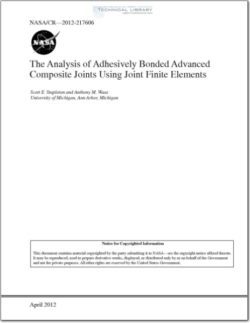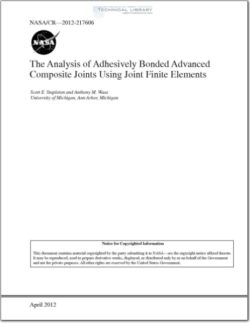NASA-CR-2012-217606

- Version
- 298 Downloads
- 3.99 MB File Size
- 1 File Count
- December 13, 2015 Create Date
- December 13, 2015 Last Updated
Analysis of Adhesively Bonded Advanced Composite Joints

Introduction
1.1 General Comments About This Thesis
Each chapter of this thesis contains work that has already being published as a conference or journal
paper, and/or is being considered for journal publication. Because of this, each chapter has an introduction
that motivates the particular aspects of the work relevant to that chapter. Therefore, in this introductory
chapter, a general but brief overview that is relevant to the thesis topic is presented.
1.2 Introduction
Joining dissimilar materials is an important and contemporary subject receiving great attention from the
aerospace engineering sector due to the large number of structural components that are being produced with
a variety of materials, including metals, polymers, fiber reinforced composites (FRCs) and structural foams
due to increasing demands on weight reduction. Traditional methods of joining, which have been largely
based on bolted joint technology, are not very suitable for joining FRCs to each other or F RCs to other
materials [1].
As bonded joints increase in popularity and use, the demand for modeling techniques increases also. In
the past, analytical models have been favored as the preferred method of predicting stresses and strength, but
finite element (FE) methods have emerged as the new standard in preliminary design due to necessity of
analyzing and designing components that contain multiple joints where analytical techniques become
intractable. FE based methods have been proven to be extremely powerful, but the small scale of the
adhesive thickness when compared to the dimensions of the surrounding structure has kept joint FE analysis
largely out of global vehicle models. A fine mesh is needed to correctly model the adhesive layer producing
an incompatibility in simultaneously analyzing the joint stresses accurately in conjunction with a very coarse
model of an entire vehicle. Therefore, the actual design and sizing of joints is often put off until a later time,
when small sub—models are used to look into the details of a vehicle.
To further complicate things, the eccentricity of the load path in most aerospace structural joints (such
as the popular single lap joint [2] featured in Figure 2-5) causes significant bending when axially loaded.
This bending-introduced rotation makes nonlinear geometric effects significant, even in early stages of
loading. Furthermore, most modern advanced polymeric adhesives show considerable nonlinear material
behavior, which causes the joint to remain intact even when the yield stress of the adhesive is reached.
Therefore, it is imperative that that these factors be included in models in order to fully utilize the superior
capability of bonded joints.
Motivated by these reasons, the overarching objective of this thesis was to develop a single finite
element that can capture accurately the stress and strain states of a bonded joint while still facilitating its
merger with the surrounding structure without having an incompatibility in finite element mesh densities.
The bonded joint element (simply referred to as "joint element") uses analytical structural models to find
shape functions for a joint, allowing the joint region to be modeled with one element. That way, with a
single element modeling the joint, it can be inserted into a larger finite element model efficiently.
Furthermore, large rotations, nonlinear material properties, and crack growth capabilities are included and
analysis guidelines are developed to keep the number of elements required to a minimum.
| File | Action |
|---|---|
| NASA-CR-2012-217606 Analysis of Adhesively Bonded Advanced Composite Joints.pdf | Download |

Comment On This Post